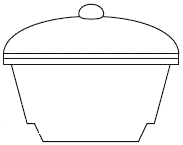Please do not block ads on this website.
No ads = no money for us = no free stuff for you!
Characteristics of a Primary Standard
A primary standard is prepared from solid compounds.
In order to be suitable for use as a primary standard, a compound must:
- be readily available (and inexpensive)
- be very pure (analytical reagent grade, 99.9% pure)
- have a known formula (eg, degree of hydration must not change)
- be unaltered in air during weighing, that is, the compound must NOT
(a) absorb moisture from the air
(b) absorb carbon dioxide from the air
(c) be oxidised by air
- have a relatively large molar mass (to minimise errors during weighing)
- be soluble (in the solvent used, and under the conditions used, to make the solution)
Primary Standards for Acid-Base Titrations
Most alkali hydroxides, such as sodium hydroxide, NaOH, are NOT suitable for use as a primary standard because they
- readily absorb moisture, H2O, from the atmosphere
- readily absorb carbon dioxide, CO2, from the atmosphere
Hydrochloric acid, HCl, and sulfuric acid, H2SO4, are NOT suitable for use as a primary standard because although they are both commercially available as concentrated solutions that are easily diluted, the concentration of the "concentrated" solution is NOT accurately known.
Nitric acid, HNO3, is NOT suitable for use as a primary standard because it always contains a little nitrous acid, HNO2, which has a destructive action on many acid-base indicators.
Some compounds that are suitable as primary standards for acid-base titrations are:
- anhydrous sodium carbonate, Na2CO3, a weak base
- potassium hydrogen phthalate, KH(C8H4O4), a weak acid
Primary Standards for Redox Titrations
Potassium permanganate, KMnO4, is NOT suitable for use as a primary standard because it
- cannot be obtained pure enough
- readily reacts with traces of organic material or other reducing substances in water
- decomposes in sunlight
Potassium dichromate, K2Cr2O7, is suitable for use as a primary standard.
Calculating Concentration of a Primary Standard
You will know:
- the name, and formula, of the compound you used as a primary standard
- m, the mass of this compound that you weighed out and transferred to volumetric flask
- V, the volume of the volumetric flask that you used to make the primary standard solution
(Note that this volume is probably in milliltres, mL)
You will need to calculate:
- M, the molar mass of the compound used as the primary standard
M(compound) = sum of the molar mass of each element multiplied by the number of atoms present in the formula
- n, the amount in moles of the compound you used as the primary standard
n = m ÷ M
- V, the volume of solution in litres
convert mL to L: V(L) = V(mL) ÷ 1000
- c, the concentration in mol L-1 of the primary standard solution you prepared
c = n ÷ V
For the preparation of the sodium carbonate primary standard solution above:
- formula: Na2CO3
- M(Na2CO3) = (2 x 22.99) + 12.01 + (3 x 16.00) = 105.99 g mol-1
- m(Na2CO3(s)) = 1.300 g
- n(Na2CO3(s)) = m ÷ M = 1.300 ÷ 105.99 = 0.012265 mol
- V(Na2CO3(aq)) = 250.00 mL
convert volume in mL to volume in L: 250.00 mL ÷ 1000 mL/L = 0.25000 L
- c(Na2CO3) = n ÷ V = 0.012265 ÷ 0.25000 = 0.04906 mol L-1
Concentration of the sodium carbonate primary standard solution prepared above is 0.04906 mol L-1.
Secondary Standard Solutions
As noted above, substances like hydrochloric acid and sulfuric acid are not suitable for use as primary standards because the concentration of the commercially available concentrated acids is not known accurately.
However, you can prepare a dilute solution of these acids with an approximate concentration, and then determine the concentration accurately by titration with a primary standard solution of a base such as sodium carbonate.
Because the accurate concentration of acid has been derived using a primary standard, the acid is referred to as a secondary standard.
Similarly, alkali hydroxides such as sodium hydroxide are unsuitable for use as primary standards because they absorb moisture and carbon dioxide from the atmosphere.
However, you can prepare a sodium hydroxide solution with an approximate concentration by weighing out some NaOH pellets and dissolving them in distilled water in a volumetric flask.
This solution can then be titrated with an acidic primary standard solution, such as potassium hydrogen phthalate, KH(C8H4O4), in order to determine the concentration of the basic solution more accurately.
Because the accurate concentration of the base has been derived using a primary standard, the base is referred to as a secondary standard.




